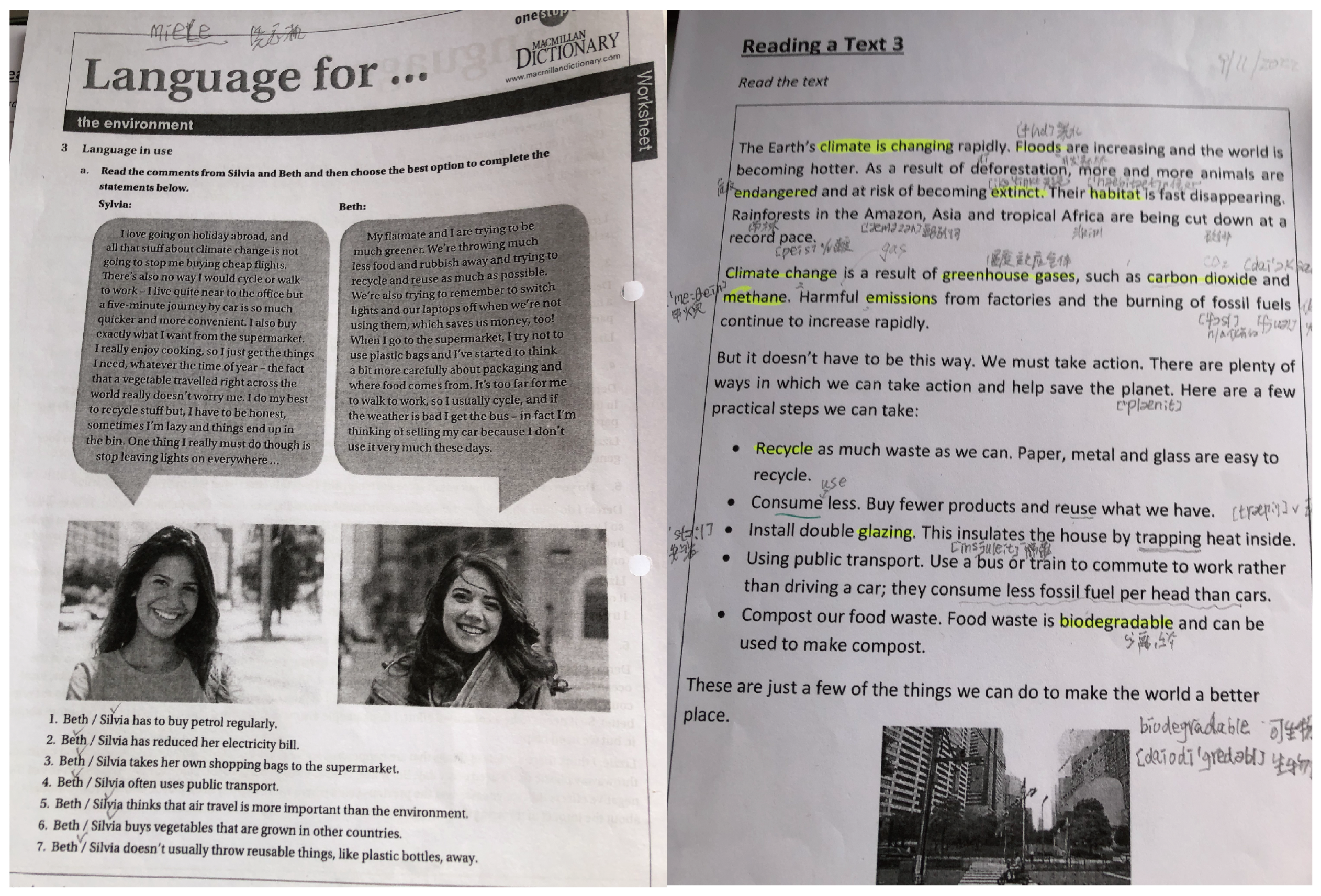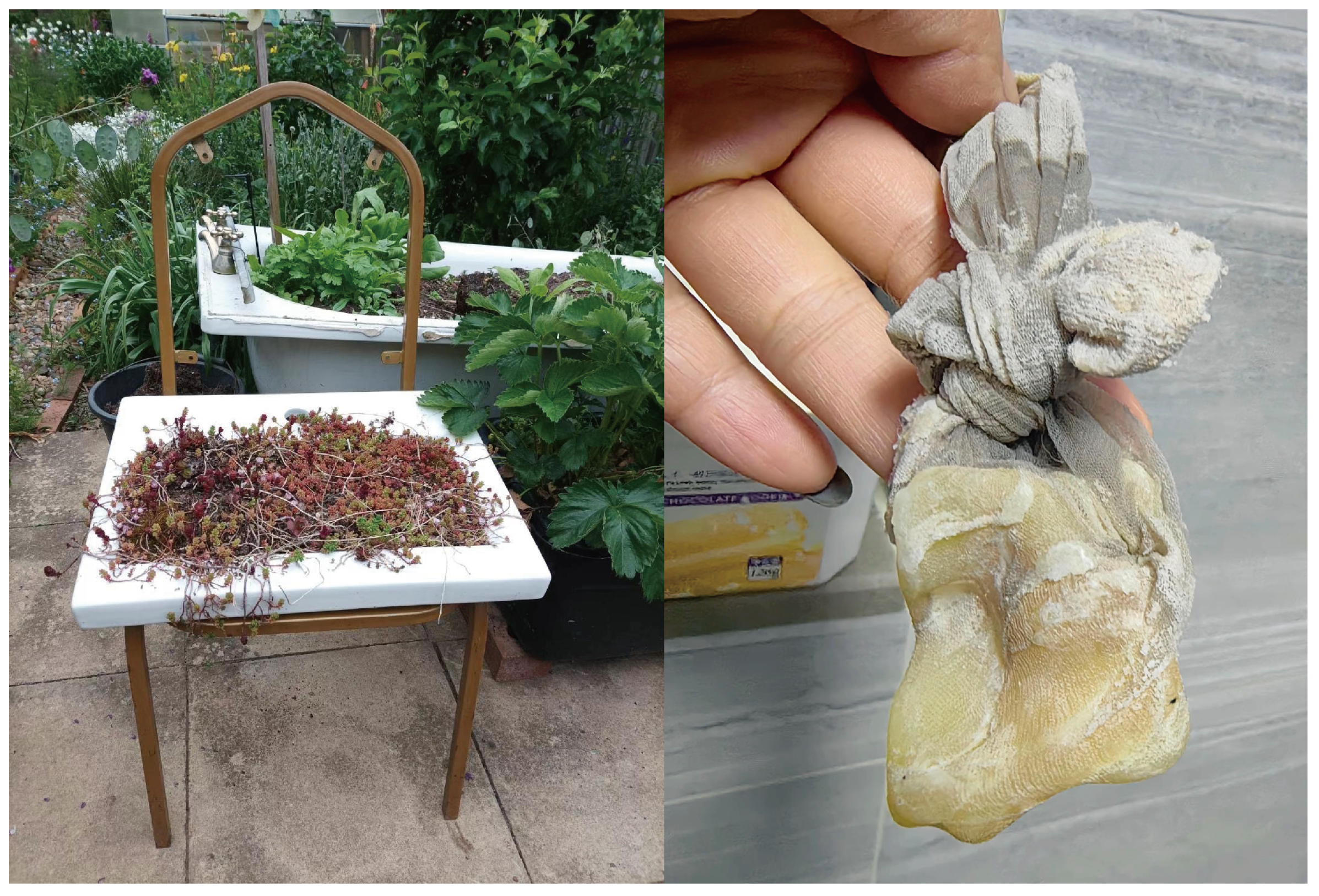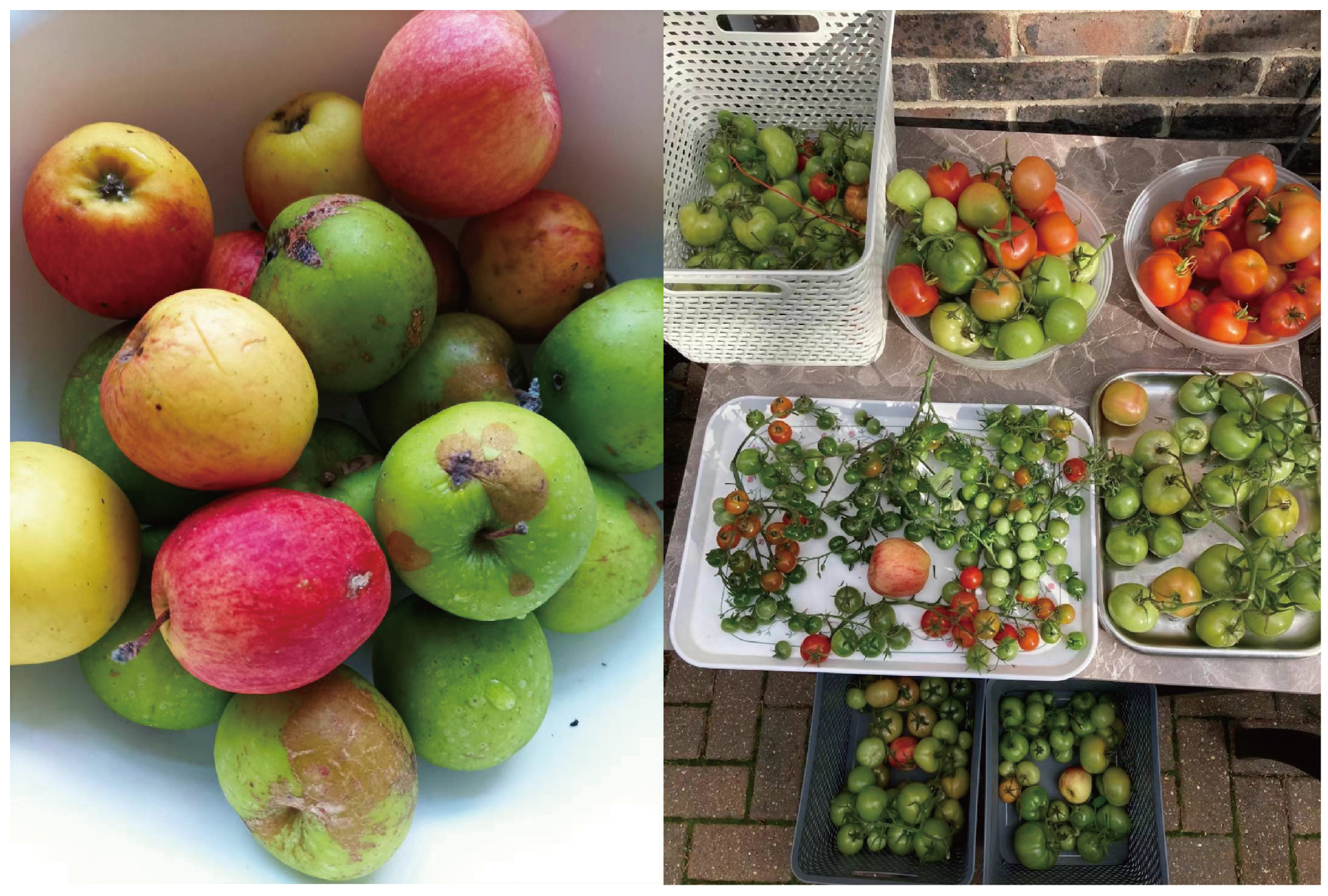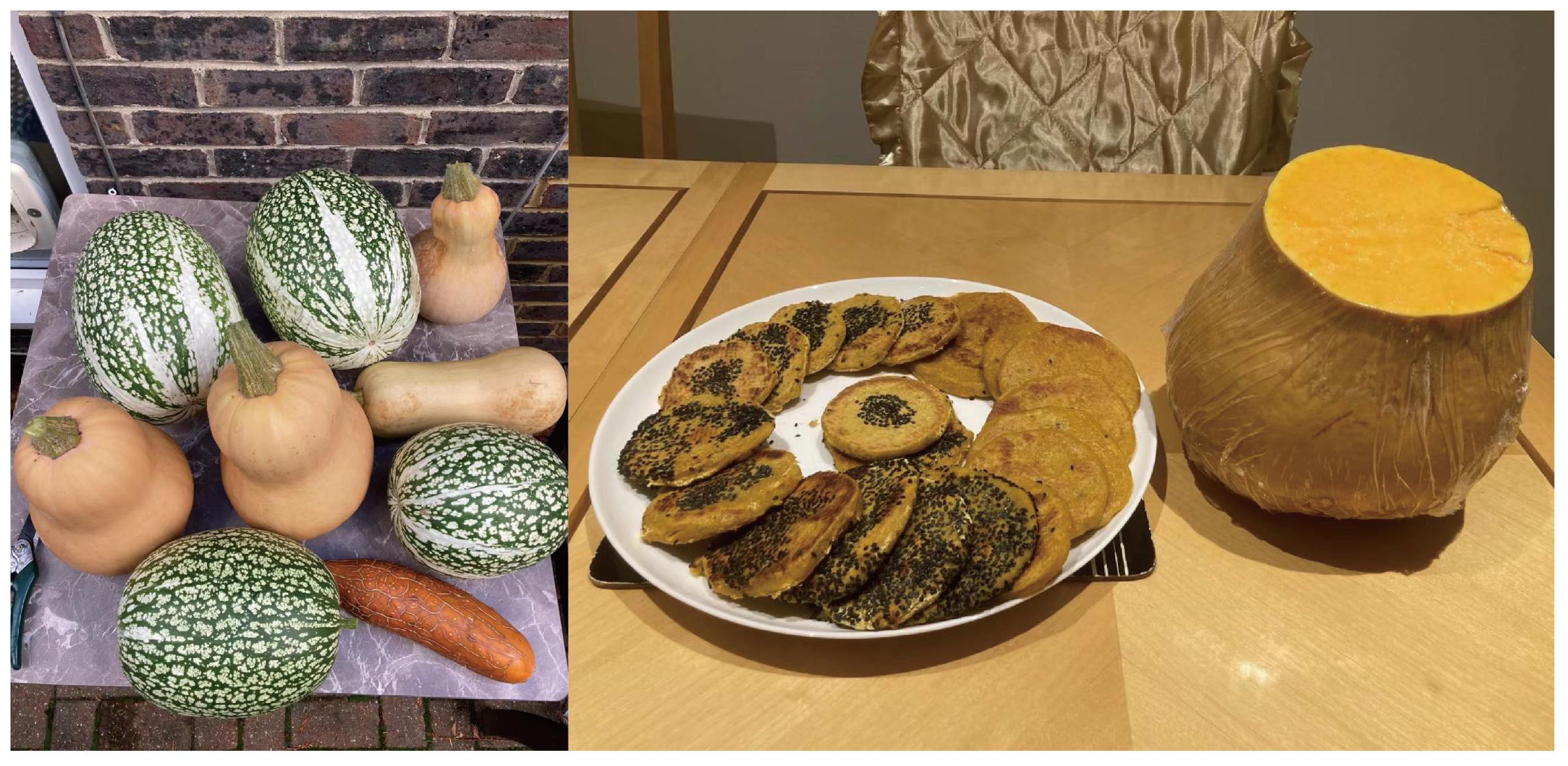Low-Carbon Practices and Cultural Adaptation Among Older Chinese Migrants: Insights from Walking Interviews on Environmental Policy and Social Integration
Abstract
1. Introduction
- How are low-carbon behaviors among older Chinese migrants in the UK shaped by cultural memory, migration experience, and everyday adaptation to their new environment?
- How do older Chinese migrants perceive generational differences in sustainability attitudes and behaviors within their families or communities?
- How do social networks and migrant-specific contexts influence their access to low-carbon information?
2. Research Background
2.1. Acculturatio
2.2. Frugality as Cultural Capital
2.3. Cultural Memory, Scarcity, and Sustainable Practices
2.4. Intergenerational Differences in Environmental Behavior
2.5. Migrants’ Sustainability Practices in Context
3. Methodology
3.1. Research Design and Rationale
3.2. Participant Recruitment and Sampling Strategy
- Migration Background: Participants represented a range of routes to the UK, including educational, employment, and family-based migration.
- Sustainability Orientation: Participants demonstrated varying degrees of environmental involvement—from highly active "environmental pioneers" to individuals facing barriers to engagement.
- Environmental Pioneers—actively engaged in sustainability efforts beyond individual practices;
- Frugal Practitioners—whose behaviors stem from thrift and necessity rather than ecological ideology;
- Adaptive Integrators—who blend host country norms with inherited cultural values.
3.3. Research Instrument Design and Validation
- In the first pilot, a participant led the researcher on an extended outdoor walk, which proved logistically and physically challenging. As a result, the protocol was adjusted to prioritize shorter, more accessible walking routes.
- In the second pilot, a participant chose a crowded supermarket as the location, where ambient noise disrupted audio recording. Subsequent interviews were therefore conducted in quieter public settings or seated areas conducive to reflective conversation.
- “Can you describe how you do your shopping in the UK? How is it different from how you used to shop in China?”
- “Have you taken specific steps to reduce waste or conserve energy? What motivates you to do this?”
- “Have you participated in any government or community programs related to the environment?”
3.4. Data Collection Procedure
- Everyday low-carbon behaviors;
- Frugality and consumption;
- Cultural adaptation and community life;
- Experiences with UK climate policies or environmental programs.
3.5. Data Analysis
- Familiarization: The researcher read through the full transcripts multiple times, making preliminary notes on key expressions and observations shared during the walks.
- Initial Coding: Using NVivo, open coding was applied to highlight specific statements, metaphors, or practices related to sustainability, migration, frugality, and identity. This phase generated an initial set of 18 codes.
- Theme Development: Codes with overlapping or conceptually similar meanings were clustered. For example, ‘language difficulties’ and ‘lack of access to public information’ were grouped under ‘Information Barriers’, while ‘use of second-hand items’ and ‘creative reuse’ were grouped under ‘Practical Frugality’.
- Theme Refinement: Themes were refined through iterative cross-coding and grouped based on semantic similarity and the frequency of co-occurrence, allowing the formation of coherent thematic clusters.
- Subthematic Structuring: For complex themes such as economic attitudes, three tiers of subthemes were introduced to reflect the nuances in participant responses. For example, under the theme of ‘Consumption and financial practices’, the subthemes included the following:
- “Responses to rising living costs”;
- “Frugality vs. aspirational consumption”;
- “Perceptions of waste and reuse”.
3.6. Trustworthiness and Triangulation
- Credibility
- Member validation was carried out by sharing the initial findings with a small group of participants and local Chinese community leaders. Their feedback was used to refine interpretations and ensure cultural accuracy.
- Prolonged engagement was maintained through multiple interactions with several participants, allowing for deeper trust and clarification.
- Transferability
- While the study focused on older Chinese migrants in urban UK contexts, detailed descriptions of participant profiles, cultural backgrounds, and environmental behaviors were provided to support transferability to other migrant populations or aging communities.
- Dependability and Confirmability
- A reflexive journal was kept throughout the research process to record methodological decisions, positionality reflections, and potential biases. These memos enhanced transparency in how themes were identified and interpreted.
- An audit trail of data coding, analysis steps, and software output (e.g., NVivo codebooks) was preserved for verification.
- Methodological Triangulation
4. Results
- Section 4.1 addresses Research Question 1, examining the barriers that prevent older Chinese migrants from engaging with local communities and environmental policies.
- Section 4.2 responds to Research Question 2, exploring the generational divergence between environmental awareness and actual low-carbon behaviors.
- Section 4.3 delves into Research Question 3, unpacking the historical, cultural, and economic roots of frugality as a form of sustainable practice.
- Section 4.4 extends the analysis by examining the dynamic interplay between adaptation and continuity in post-migration life, highlighting why some lifestyle habits shift while others persist.
4.1. Integration and Policy Engagement:Barriers to Local Participation Among Older Chinese Migrants
4.1.1. Language Barriers: The First Hurdle to Integration
“When I first arrived in the UK, I didn’t even know how to use the bus or read the coins. Life felt completely disorienting—like being a newborn, except filled with fear.” — Shun (Female, 55+, Mainland China)
“At university, I studied Russian, not English. When I came to the UK, I was too afraid to ask for directions. Now I can handle daily conversations, but I still struggle with formal language—legal documents, for example, are a nightmare. But I keep learning, even now at 79.” — Rui (Female, 75+, Mainland China)
“Many migrants make the mistake of staying within their language bubble. But that means you never really know what’s happening in the country.” — He (Female, 60+, Malaysia)
4.1.2. Cultural Differences and Social Barriers
Differences in Social Interaction Patterns
“Most of my weekdays revolve around my children and grandchildren. Now that they’re older, I finally have time to attend weekend dance classes at the Chinese community center.” — Fa (Female, 65+, Mainland China)
Discrimination and Prejudice
“As a Chinese woman, I faced both sexism and racism in my early career, but I pushed through. You must keep improving yourself if you want to succeed in the West.” — He (Female, 60+, Malaysia)
“We came in the 1980s, and discrimination was everywhere. We tried to hide our ‘Chinese-ness’ just to blend in. Things have changed now—but I can’t tell if that’s because of our age or because China’s status has risen.” — Jiao (Female, 60+, Mainland China)
“Back home, we were the ‘pillar generation’. Here, we’re invisible.” — Niqiu (Male, 55+, Mainland China)
4.1.3. Political Apathy and Scepticism
Political Apathy
“If something doesn’t directly affect my life, I don’t pay attention to it.” — Chen (Male, 55+, Malaysia)
“I understand the importance of sustainability. But not everyone listens—especially Chinese people. Many just don’t care.” — Shun (Female, 55+, Mainland China)
Scepticism Towards Local Policies
“The government keeps changing, but meaningful environmental policies? Rare. I don’t really trust what politicians say.” — Huang (Female, 60+, Taiwan)
“A lot of these so-called ‘green policies’ are just hidden tax schemes. They create the problems, then sell the solutions.” — Huang (Male, 70+, Hong Kong)
4.1.4. Personality Traits and Self-Perception
“Chinese and Taiwanese people tend to be shy. We fear making grammar mistakes. But why? They can’t speak our language either. We should be confident.” — Huang (Female, 60+, Taiwan)
“Many migrants isolate themselves in the Chinese circle. Their English doesn’t improve, so they become even more reluctant to speak. It’s a mindset issue.” — Tao (Female, 55+, Mainland China)
4.1.5. Economic Pressures and Ethnic Self-Sufficiency: Survival First, Integration Later
“Many Chinese in the takeaway industry came as undocumented migrants. They plan to return home before retirement—they’ve already built houses back in China.” — Xiao (Female, 60+, Mainland China)
“Fujianese people abroad care only about one thing: making money. Integration doesn’t even cross their mind.” — Glasses (Male, 55+, Mainland China)
“I need to save for my son’s wedding and house. In China, parents still carry these responsibilities, even when the child has grown.” — Amy (Female, 55+, Mainland China)
“My duty was to raise my child. Now that she’s graduating, I’ll return to China for retirement.” — Zhang (Male, 55+, Mainland China)
“I don’t have many friends in the UK, and those I do have are mostly Chinese. Especially during the pandemic, since my last holiday in February 2020, I’ve barely left my small town. For elderly people, the virus was a major concern, so I avoided any external contact.” — Xiao (Female, 60+, Mainland China)
“I lived in Australia for years—there are even more Chinese there. You can do everything in Mandarin: groceries, banking, even getting legal help.” — Li (Female, 55+, Mainland China)
4.2. Awareness–Action Gap Across Generations: Why Younger Migrants Understand Policies Better, but Older Migrants Practice More
4.2.1. Information Access and the Awareness–Practice Gap
- Younger Migrants (Second-Generation and International Students)
- Tend to access environmental information more easily through digital media, formal education, and social networks.
- Display higher awareness of UK climate policies and sustainability discourse due to stronger English skills and schooling in the UK.
- However, there is often a gap between their environmental knowledge and everyday behavior.
“My son often sends me news articles and links to keep me updated. That’s how I first learned about ‘low-carbon’ policies. But in China, this topic still isn’t discussed much.” — Rui (Female, 75+, Mainland China)
“The next generation definitely has better English. Many of them were born here and fully understand the local system.” — Huang (Male, 70+, Hong Kong)
- Older Migrants (First-Generation, Aged 55+)
- Rely on Chinese-language media and word-of-mouth in ethnic communities for information.
- Engage in low-carbon behaviors due to deeply rooted frugality and resource-conscious habits, rather than policy awareness.
- The walking interviews revealed a range of such practices embedded in daily life.
- Examples of Frugal, Low-Carbon Practices
- 1.
- Conscious Spending and Minimal Waste
“I only buy clothes when I really need them, or during big discounts. I hate waste. If something can still be used, I use it or donate it.” — He (Female, 60+, Malaysia)
“If you go to the supermarket before it closes, bread that costs £1 can go down to 20p. Vegetables too. You just need to know where to look.” — Jian (Female, 65+, Mainland China)
- 2.
- Energy Efficiency
“We don’t turn on the heating all day. We keep curtains shut to preserve heat and only adjust the temperature when needed. We even use firewood when possible.” — Zhang (Male, 55+, Mainland China)
- 3.
- Composting and Rainwater Use
“We compost fruit peels and collect rainwater in barrels for our plants. I reuse laundry water to mop the floor. It’s just how we live.” — Xiao (Female, 60+, Mainland China)
- 4.
- Repurposing Clothes
“If something doesn’t fit anymore, I alter it. If it’s damaged but still usable, I fix it and wear it again.” — Rui (75+, Mainland China)
- 5.
- Avoiding Food Waste
“I never waste food. I use what I have and fix what I can. Christmas sales? I don’t buy unless I really need something.” — Huang (Female, 60+, Taiwan)
- 6.
- Reusable Bags and Household Recycling
“We haven’t bought plastic bags in years. I sew shopping bags from old clothes and even my children’s school uniforms.”
- 7.
- Growing Vegetables at Home
“I grow chives, coriander, and spinach—more than we can eat. I share with friends and enjoy seeing them happy.” “I think gardening is something very Chinese. In rural China, every household had chilies, eggplants, and vegetables growing in their yard. It’s not about money—of course, we can afford supermarket food—it’s about making use of our time meaningfully and staying healthy in retirement.” — Jian (Female, 65+, Mainland China)
“Homegrown food just tastes better. Since retiring, I hardly buy vegetables anymore.” — Ye (Male, 60+, Mainland China)
“Vegetables grown by yourself just taste different. The process—from planting to cooking—makes you appreciate food more.”
4.2.2. Historical Memory and the Habit of Saving
- Older adults internalized frugality through lived experience—often linked to famine, war, and national austerity campaigns.
- Younger generations, raised during periods of economic reform and expansion, had more access to material goods and developed different consumption habits, even though they may still respect the values of thrift.
“As my parents say, ‘Each generation is less frugal than the last.’ My children don’t waste on purpose, but they haven’t lived through hardship, so they don’t see the value in small savings.” — Leng (Female, 60+, Mainland China)
“My grandmother lived through starvation. She would never waste a single grain of rice. That kind of experience stays with you.” — Huang (Male, 70+, Hong Kong)
“Now we have Chinese supermarkets everywhere. Back in my day, my mother had to send me parcels from China every month.” — He (Female, 60+, Malaysia)
“The older people in my village grew up starving. In Luoyang, people didn’t say ‘Have you eaten?’—they asked ‘Have you had soup?’ That’s how poor we were. Even now, the elderly always finish their meals and save everything. Their children don’t understand why they keep so much ‘useless junk.’” — Xiao (Female, 60+, Mainland China)
“Older people never waste food. We younger ones never experienced that kind of hunger, so we don’t really understand. But hearing their stories, it makes sense—they lived through starvation in the 1950s. Those were very hard times.” — Jian (Female, 65+, Mainland China)
4.2.3. Spending Habits and Consumer Culture
“Today’s young people spend too freely—luxury handbags, fast fashion. Our generation saves first, spends later.” — Huang (Female, 60+, Taiwan)
“Western thinking is catching on—borrow now, enjoy today. Mortgages make sense sometimes, but saving gives peace of mind.” — Ye (Male, 60+, Mainland China)
4.3. Frugality as Cultural Practice
4.3.1. Confucian Values and Social Norms
“Traditional Chinese culture values loyalty, collectivism, and personal sacrifice. Frugality is part of this—it’s about being responsible to your family and community.” — Zhang (Male, 55+, Mainland China)
“We were taught not to waste anything—don’t use paper unnecessarily, don’t buy things you don’t need. It’s just a habit from our generation.” — Xiao (Female, 60+, Mainland China)
4.3.2. Economic Conditions and Welfare Adaptation: Between Scarcity Memory and Present Stability
“Back in China, I was laid off. But here in the UK, I can rely on my husband’s pension. I don’t talk to my old friends in China anymore—their lives are too different. I can travel and enjoy life, while they’re still struggling just to get by.” — Piao (Female, 60+, Mainland China)
“If I were still in China, I’d have only 2,000–3,000 yuan a month in pension. That’s not enough to live on. But here, the UK government supports us. I can retire without fear.” — Xiao (Female, 60+, Mainland China)
“When my husband got brain cancer, the UK system really helped us. They immediately gave us disability status, plus £500 per month, daily nurse visits, and transport subsidies. It’s not just words—it’s a real safety net.” — Xiao (Female, 60+, Mainland China)
4.4. Continuity and Change After Migration
4.4.1. External Adaptation: Language, Diet, and Consumption
Environmental Adaptation
“There were no Chinese supermarkets back then. Every weekend, I had to travel from Oxford to London’s Chinatown with a full backpack just to bring home enough ingredients. Now, Chinese food is trendy—even British supermarkets stock condiments. But back in those days, we couldn’t even find spring onions or ginger.” — Jiao (Female, 60+, Mainland China)
“I eat more Western food now. But when I crave Taiwanese or Chinese dishes, I cook them for myself. My husband sticks to his usual Western meals—we each enjoy our own preferences.” — Huang (Female, 60+, Taiwan)
Social Influence
“At Chinese gatherings, people used to bring homemade food. But now, especially in mixed-nationality families, many bring store-bought items from British supermarkets. At first, I thought they’d taste bad—but they’re actually quite good. We used to make everything from scratch, but now I find supermarket options more convenient.” — Fa (Female, 60+, Mainland China)
“Working in a multicultural environment really broadens your perspective. You learn how different cultures communicate and how to collaborate beyond just your own circle.” — He (Female, 60+, Malaysia)
“To improve my English, I joined a local club where I chat, cook, and have tea with British people. It helped me speak more naturally and get used to their communication style.” — Amy (Female, 55+, Mainland China)
Economic Shifts and New Spending Patterns
“In the UK, I’ve bought a lot of luxury items—but always on sale. Back in China, I wouldn’t even consider these things. But now my kids are grown up, and I have the freedom to enjoy life. People say it’s materialistic—I call it pleasure.” — Li (Female, 55+, Mainland China)
“During the pandemic, I couldn’t travel, so I had extra money. I even treated myself to beauty services for the first time. I shop with my neighbours now—sometimes I buy too much and just give it away if I don’t like it later.” — Piao (Female, 60+, Mainland China)
“Here, if your savings go over £15,000, your benefits are reduced. So people say, ‘spend aggressively’ to keep entitlements. It’s the opposite of China, where you save in case of illness. With free healthcare here, you don’t need to stockpile savings.” — Piao (Female, 60+, Mainland China)
4.4.2. Cultural Continuity: Deeply Rooted Values Persist
“Frugality is part of my culture, and I’ve always kept that belief. I may wear jeans now, but during Lunar New Year, I still put on traditional Chinese clothes. I’ve adapted to Western life in some ways, but Chinese values remain.” — He (Female, 60+, Malaysia)
“We Chinese save for emergencies. Many British people rely on credit—they spend first and worry later. That kind of lifestyle creates stress, especially now with inflation and strikes.” — Rui (Female, 75+, Mainland China)
“Even after so many years in the UK, I haven’t changed my financial habits. I still save. Spending next month’s salary in advance just feels wrong to me. I guess it’s an Asian thing—we need that sense of security.” — Huang (Female, 60+, Taiwan)
5. Discussion
5.1. Key Findings and Interpretation
5.1.1. Frugality: Cultural Legacy or Economic Response?
5.1.2. Between Tradition and Comfort: Negotiating Consumption
5.1.3. Social Exclusion and Quiet Sustainability
5.1.4. Awareness Without Action? Generational Sustainability Tensions
5.1.5. Rethinking Inclusion in Environmental Narratives
5.1.6. Interplay of Cultural, Economic, and Social Factors
5.2. Reflections on the Walking Interview Method
5.3. Limitations and Future Research
5.4. Implications for Policy and Practice
- Recognize and integrate migrant frugality into sustainability planning. Instead of viewing older migrants’ thrift-based behaviors as outdated, policy frameworks should consider them as assets. Practices such as repair, reuse, and resource-sharing can be promoted through culturally sensitive campaigns.
- Partner with ethnic institutions for outreach. Trusted community nodes—such as Chinese community centers, churches, Chinese-language newspapers, and grocery stores—are critical entry points. Environmental messages can be effectively distributed through local Chinese organizations, WeChat groups, Xiaohongshu (RED), and even TikTok videos in Mandarin/Cantonese.
- Leverage intergenerational collaboration. Programs that encourage younger migrants to act as policy interpreters or digital facilitators for older family members can bridge the awareness–practice divide. These initiatives can build mutual respect and promote sustainability within households.
- Embed climate communication within culturally resonant narratives. Messages framed around frugality, family responsibility, and care for future generations may resonate more than abstract concepts like “carbon footprint” or “net-zero targets.” Policymakers should adapt language and framing to local cultural contexts.
- Identify and support community sustainability champions. Migrants already practicing “quiet sustainability” could serve as peer educators. Informal influencers within ethnic networks can lead workshops or storytelling events to share lived experiences of low-carbon lifestyles.
5.5. Conclusions
Author Contributions
Funding
Institutional Review Board Statement
Informed Consent Statement
Data Availability Statement
Conflicts of Interest
Appendix A. Themes and Subthemes
| Theme | Subtheme | Sub-Subtheme |
| 1. Language and Integration | 1.1 Language Barriers and Adaptation | 1.1.1 Difficulties Caused by Language; 1.1.2 Reliance on Translation Tools and Services |
| 1.2 Importance of Language Learning | 1.2.1 Methods to Improve English Proficiency; 1.2.2 Impact of Language Skills on Employment | |
| 1.3 Social and Cultural Integration | 1.3.1 Insularity of Chinese Social Circles; 1.3.2 Lack of Confidence to Communicate | |
| 2. Cultural Adaptation and Integration | 2.1 Value of a Multicultural Work Environment | — |
| 2.2 Cultural Conflict and Adjustment | 2.2.1 Differences Between Chinese and Western Values; 2.2.2 Challenges of Adapting to British Society | |
| 2.3 Enhancing Integration Through Social Activities | 2.3.1 Participation in Local Community Events; 2.3.2 Making Friends Through Hobbies | |
| 3. Economic and Consumption Concepts | 3.1 Changes in Cost of Living | 3.1.1 Impact of Price Increases on Daily Life; 3.1.2 Adjustments in Shopping Habits |
| 3.2 Frugality and Consumption Habits | 3.2.1 Traditional Views on Frugality; 3.2.2 Advance Spending Among the Younger Generation | |
| 3.3 Impact of the UK Welfare System on Consumption | — | |
| 4. Work and Life Challenges | 4.1 Hard Work Experiences of Chinese Migrants | — |
| 4.2 Feeling Marginalized in British Society | — | |
| 4.3 Goal of Chinese Migrants: Earn Money and Return Home | 4.3.1 Short-term Work and Retirement Plans in China; 4.3.2 Special Circumstances of Migrants from Fujian | |
| 5. Access to Information and Social Participation | 5.1 Proactively Seeking Information | 5.1.1 Adapting to Local Media and News Sources |
| 5.2 Support and Activities from Chinese Communities | 5.2.1 Mutual Aid Organizations; 5.2.2 Cultural Festival Events | |
| 6. Values and Beliefs | 6.1 Confucianism vs. Western Individualism | — |
| 6.2 Differences in Moral Concepts | — | |
| 6.3 Skepticism Towards UK Policies | 6.3.1 Authenticity of UK Environmental Policies; 6.3.2 Fairness of Government Welfare System | |
| 7. Lifestyle and Health | 7.1 Changes in Dietary Habits | 7.1.1 Adapting to Western Food; 7.1.2 Combining Chinese and Western Dietary Styles |
| 7.2 Health Preservation and Healthy Eating | — | |
| 7.3 Interest in Gardening (Growing Fruits and Vegetables) | — | |
| 8. Environmental Awareness and Social Responsibility | 8.1 Low-Carbon Education and Environmental Awareness | — |
| 8.2 Indifferent Attitudes Towards Environmental Protection | — | |
| 8.3 Supporting Environmentalism but Avoiding Discussion | — |
References
- Aldy, J.E.; Orszag, P.R.; Stiglitz, J.E. Climate Change: An Agenda for Global Collective Action; Prepared for the Conference on the Timing of Climate Change Policies, Pew Center on Global Climate Change: Washington, DC, USA, 2001; Brookings Institution; Available online: https://www.brookings.edu/wp-content/uploads/2016/06/10_climatechange_orszag.pdf (accessed on 18 May 2025).
- IPCC. Climate Change 2022: Mitigation of Climate Change. Contribution of Working Group III to the Sixth Assessment Report; Cambridge University Press: Cambridge, UK; New York, NY, USA, 2022; Chapter 5: Demand, Services and Social Aspects of Mitigation. [Google Scholar]
- Fernandez-Bou, A.S.; Ortiz-Partida, J.P.; Dobbin, K.B.; Flores-Landeros, H.; Bernacchi, L.A.; Medellín-Azuara, J. Underrepresented, understudied, underserved: Gaps and opportunities for advancing justice in disadvantaged communities. Environ. Sci. Policy 2021, 122, 92–100. [Google Scholar] [CrossRef]
- Frumkin, H.; Fried, L.; Moody, R. Aging, climate change, and legacy thinking. Am. J. Public Health 2012, 102, 1434–1438. [Google Scholar] [CrossRef] [PubMed]
- White, P. Migrant populations approaching old age: Prospects in Europe. J. Ethn. Migr. Stud. 2006, 32, 1283–1300. [Google Scholar] [CrossRef]
- Wilson, T.; McDonald, P.; Temple, J.; Brijnath, B.; Utomo, A. Past and projected growth of Australia’s older migrant populations. Genus 2020, 76, 20. [Google Scholar] [CrossRef] [PubMed]
- Sixsmith, A.; Sixsmith, J. Ageing in place in the United Kingdom. Ageing Int. 2008, 32, 219–235. [Google Scholar] [CrossRef]
- Choi, Y.; Duffy, R.D.; Kim, T.; Bridges, B.; Perez, G.; Kim, H.J.; Park, J.; Steranka, M. Social Mobility Among United States Immigrants: A Psychology of Working Perspective. Couns. Psychol. 2025, 53, 38–67. [Google Scholar] [CrossRef]
- Fry, C.; Boyd, E.; Connaughton, M.; Adger, W.N.; Gavonel, M.F.; Zickgraf, C.; Fransen, S.; Jolivet, D.; Fábos, A.H.; Carr, E. Migrants as sustainability actors: Contrasting nation, city and migrant discourses and actions. Glob. Environ. Change 2024, 87, 102860. [Google Scholar] [CrossRef]
- Head, L.; Klocker, N.; Dun, O.; Waitt, G.; Goodall, H.; Aguirre-Bielschowsky, I.; Gopal, A.; Kerr, S.M.; Nowroozipour, F.; Spaven, T.; et al. Barriers to and enablers of sustainable practices: Insights from ethnic minority migrants. Local Environ. 2021, 26, 595–614. [Google Scholar] [CrossRef]
- Sovacool, B.K.; Griffiths, S. The cultural barriers to a low-carbon future: A review of six mobility and energy transitions across 28 countries. Renew. Sustain. Energy Rev. 2020, 119, 109569. [Google Scholar] [CrossRef]
- Boffa, Z.M. Cultural Influence on China’s Household Saving. Ph.D. Thesis, Federation University Australia, Victoria, Australia, 2015. [Google Scholar]
- Hobson, K. Thinking habits into action: The role of knowledge and process in questioning household consumption practices. Local Environ. 2003, 8, 95–112. [Google Scholar] [CrossRef]
- Shove, E. Beyond the ABC: Climate change policy and theories of social change. Environ. Plan. A 2010, 42, 1273–1285. [Google Scholar] [CrossRef]
- Tong, H.; Walsh, C.A.; Bouchard, N.; Lai, D.W. Social inclusion and immigrant older adults. In Handbook of Social Inclusion: Research and Practices in Health and Social Sciences; Springer: New York, NY, USA, 2022; pp. 769–790. [Google Scholar]
- Lin, S.; Wu, F.; Li, Z. Social integration of migrants across Chinese neighbourhoods. Geoforum 2020, 112, 118–128. [Google Scholar] [CrossRef]
- Ayalon, L.; Roy, S.; Aloni, O.; Keating, N. A scoping review of research on older people and intergenerational relations in the context of climate change. Gerontologist 2023, 63, 945–958. [Google Scholar] [CrossRef] [PubMed]
- Liang, J.; Li, J.; Cao, X.; Zhang, Z. Generational differences in sustainable consumption behavior among Chinese residents: Implications based on perceptions of sustainable consumption and lifestyle. Sustainability 2024, 16, 3976. [Google Scholar] [CrossRef]
- Stern, P.C.; Dietz, T.; Abel, T.; Guagnano, G.A.; Kalof, L. A value-belief-norm theory of support for social movements: The case of environmentalism. Hum. Ecol. Rev. 1999, 6, 81–97. [Google Scholar]
- Welch, D.; Warde, A. Theories of practice and sustainable consumption. In Handbook of Research on Sustainable Consumption; Reisch, L.A., Thøgersen, J., Eds.; Edward Elgar Publishing: Cheltenham, UK, 2015; pp. 84–100. [Google Scholar] [CrossRef]
- Shove, E.; Pantzar, M.; Watson, M. The Dynamics of Social Practice: Everyday Life and How It Changes; Sage Publications: London, UK, 2012. [Google Scholar]
- Bourdieu, P. The forms of capital (1986). Cult. Theory Anthol. 2011, 1, 949. [Google Scholar]
- Throsby, D. Cultural capital. J. Cult. Econ. 1999, 23, 3–12. [Google Scholar] [CrossRef]
- Berry, J.W. Acculturation: A Conceptual Overview. In Acculturation and Parent-Child Relationships; Bornstein, M.H., Cote, L.R., Eds.; Routledge: London, UK, 2006; pp. 13–32. [Google Scholar]
- Berry, J.W. Immigration, acculturation, and adaptation. Appl. Psychol. 1997, 46, 5–34. [Google Scholar] [CrossRef]
- Berry, J.W. Migrant acculturation and adaptation. Oxf. Textb. Migr. Psychiatry 2021, 52021, 311. [Google Scholar]
- Kim, Y.Y. Cross-Cultural Adaptation. In Oxford Research Encyclopedia of Communication; Oxford University Press: Oxford, UK, 2017. [Google Scholar]
- Chen, Y.M. Older Chinese Migrants in Auckland City: Language, Coping Strategies, and Well-Being. Ph.D. Thesis, The University of Auckland, Auckland, New Zealand, 2025. [Google Scholar]
- Clarke, L.; Agyeman, J. Shifting the balance in environmental governance: Ethnicity, environmental citizenship and discourses of responsibility. Antipode 2011, 43, 1773–1800. [Google Scholar] [CrossRef]
- Lien, P.T.; Conway, M.M.; Wong, J. The Politics of Asian Americans: Diversity and Community; Routledge: New York, NY, USA, 2004; pp. 1–284. [Google Scholar] [CrossRef]
- Liu, S. Chinese Migrants Ageing in a Foreign Land: Home Beyond Culture; Routledge: London, UK, 2019; pp. 1–122. [Google Scholar] [CrossRef]
- Ajzen, I. The theory of planned behavior. Organ. Behav. Hum. Decis. Process. 1991, 50, 179–211. [Google Scholar] [CrossRef]
- Conner, M. Theory of Planned Behavior. In Handbook of Sport Psychology, 4th ed.; Tenenbaum, G., Eklund, R.C., Eds.; Wiley: Hoboken, NJ, USA, 2020; pp. 1–18. [Google Scholar] [CrossRef]
- Hassan, L.M.; Shiu, E.; Parry, S. Addressing the cross-country applicability of the theory of planned behaviour (TPB): A structured review of multi-country TPB studies. J. Consum. Behav. 2016, 15, 72–86. [Google Scholar] [CrossRef]
- Chun, H. The Influence of Culture and Other Factors on Consumer Attitudes Towards Sustainable Consumption. Master’s Thesis, Universitat Politècnica de Catalunya, Barcelona, Spain, 2024. Available online: http://hdl.handle.net/2117/405240 (accessed on 18 May 2025).
- Evans, D. Thrifty, green or frugal: Reflections on sustainable consumption in a changing economic climate. Geoforum 2011, 42, 550–557. [Google Scholar] [CrossRef]
- Boucher, J.L. The logics of frugality: Reproducing tastes of necessity among affluent climate change activists. Energy Res. Soc. Sci. 2017, 31, 223–232. [Google Scholar] [CrossRef]
- Tu, W.-m. (Ed.) Confucian Traditions in East Asian Modernity: Moral Education and Economic Culture in Japan and the Four Mini-Dragons; Harvard University Press: Cambridge, MA, USA, 1996. [Google Scholar]
- Ma, G. Similar or different? A comparison of environmental behaviors of US-born whites and Chinese immigrants. J. Int. Migr. Integr. 2019, 20, 1203–1223. [Google Scholar] [CrossRef]
- Yan, Y. The Individualization of Chinese Society; Routledge: London, UK, 2009. [Google Scholar]
- Zhang, W. Chinese Exceptionalism? Conspicuous Consumption versus Conspicuous Frugality among the Chinese Middle Class. Ph.D. Dissertation, Boston University, Boston, MA, USA, 2012. ProQuest Dissertations & Theses, 3500658. [Google Scholar]
- Qi, X.; Yu, H.; Ploeger, A. Exploring influential factors including COVID-19 on green food purchase intentions and the intention–behaviour gap: A qualitative study among consumers in a Chinese context. Int. J. Environ. Res. Public Health 2020, 17, 7106. [Google Scholar] [CrossRef]
- Carrete, L.; Castaño, R.; Felix, R.; Centeno, E.; González, E. Green consumer behavior in an emerging economy: Confusion, credibility, and compatibility. J. Consum. Mark. 2012, 29, 470–481. [Google Scholar] [CrossRef]
- Whitmarsh, L.; O’Neill, S. Green identity, green living? The role of pro-environmental self-identity in determining consistency across diverse pro-environmental behaviours. J. Environ. Psychol. 2010, 30, 305–314. [Google Scholar] [CrossRef]
- Inglehart, R.F. Cultural Evolution: People’s Motivations Are Changing, and Reshaping the World; Cambridge University Press: Cambridge, UK, 2018. [Google Scholar]
- Blanchard, O.; Giavazzi, F. Rebalancing growth in China: A three-handed approach. China World Econ. 2006, 14, 1–20. [Google Scholar] [CrossRef]
- Prasad, E.; Chamon, M. Why Are Saving Rates of Urban Households in China Rising; IMF Working Paper No. WP/08/145; International Monetary Fund: Washington, DC, USA, 2008. [Google Scholar]
- Kraay, A. Household saving in China. World Bank Econ. Rev. 2000, 14, 545–570. [Google Scholar] [CrossRef]
- Kuijs, L. Investment and Saving in China; World Bank Policy Research Working Paper No. 3633; World Bank: Beijing, China, 2005. [Google Scholar]
- Leung, J.T.Y.; Shek, D.T.L. “All I can do for my child”–Development of the Chinese Parental Sacrifice for Child’s Education Scale. Int. J. Disabil. Hum. Dev. 2011, 10, 253–259. [Google Scholar] [CrossRef]
- Handy, F.; Katz-Gerro, T.; Greenspan, I.; Vered, Y. Intergenerational disenchantment? Environmental behaviors and motivations across generations in South Korea. Geoforum 2021, 121, 53–64. [Google Scholar] [CrossRef]
- Barr, S.; Gilg, A. Sustainable lifestyles: Framing environmental action in and around the home. Geoforum 2006, 37, 906–920. [Google Scholar] [CrossRef]
- Hastings, P.D.; McShane, K.E.; Parker, R.; Ladha, F. Ready to make nice: Parental socialization of young sons’ and daughters’ prosocial behaviors with peers. J. Genet. Psychol. 2007, 168, 177–200. [Google Scholar] [CrossRef] [PubMed]
- Swartz, D.L. The sociology of habit: The perspective of Pierre Bourdieu. Otjr Occup. Particip. Health 2002, 22, 61S–69S. [Google Scholar] [CrossRef]
- Meeusen, C. The intergenerational transmission of environmental concern: The influence of parents and communication patterns within the family. J. Environ. Educ. 2014, 45, 77–90. [Google Scholar] [CrossRef]
- Grusec, J.E.; Davidov, M. Integrating different perspectives on socialization theory and research: A domain-specific approach. Child Dev. 2010, 81, 687–709. [Google Scholar] [CrossRef]
- Katz-Gerro, T.; Greenspan, I.; Handy, F.; Vered, Y. Environmental behavior in three countries: The role of intergenerational transmission and domains of socialization. J. Environ. Psychol. 2020, 71, 101343. [Google Scholar] [CrossRef]
- Volland, B. On the intergenerational transmission of preferences. J. Bioeconomics 2013, 15, 217–249. [Google Scholar] [CrossRef]
- Dragolea, L.L.; Butnaru, G.I.; Kot, S.; Zamfir, C.G.; Nuţă, A.C.; Nuţă, F.M.; Cristea, D.S.; Ştefănică, M. Determining factors in shaping the sustainable behavior of the generation Z consumer. Front. Environ. Sci. 2023, 11, 1096183. [Google Scholar] [CrossRef]
- Stern, P.C. New environmental theories: Toward a coherent theory of environmentally significant behavior. J. Soc. Issues 2000, 56, 407–424. [Google Scholar] [CrossRef]
- Schatzki, T.R. The Timespace of Human Activity: On Performance, Society, and History as Indeterminate Teleological Events; Lexington Books, a division of Rowman & Littlefield Publishers, Inc.: Lanham, MD, USA, 2010; ISBN 978-0-7391-4268-4. [Google Scholar]
- Mavroudi, E.; Nagel, C. Global Migration: Patterns, Processes and Politics, 2nd ed.; Routledge: London, UK, 2023; ISBN 9780367822941. [Google Scholar] [CrossRef]
- Lila, A. The Development of Circular Economy in China as a National Strategy. Master’s Thesis, Università Ca’ Foscari Venezia, Venice, Italy, 2022. Supervised by Ch. Prof. Daniele Brombal; Assistant Supervisor Ch. Prof. Beatrice Galelli. [Google Scholar]
- Peters, M.; Fudge, S.; Sinclair, P. Mobilising community action towards a low-carbon future: Opportunities and challenges for local government in the UK. Energy Policy 2010, 38, 7596–7603. [Google Scholar] [CrossRef]
- Revell, K. Promoting sustainability and pro-environmental behaviour through local government programmes: Examples from London, UK. J. Integr. Environ. Sci. 2013, 10, 199–218. [Google Scholar] [CrossRef]
- Fry, C.; Zickgraf, C.; Boyd, E.; Jolivet, D.; Siddiqui, T.; Fransen, S.; Gavonel, M.F.; Adger, N.; Fábos, A.; Connaughton, M.; et al. Policy insights on the migration–sustainability nexus for urban governance. Glob. Sustain. 2024, 7, e51. [Google Scholar] [CrossRef]
- Mah, J. Broadening equitable planning: Understanding indirect displacement through seniors’ experiences in a resurgent Downtown Detroit. Environ. Plan. Econ. Space 2023, 55, 905–922. [Google Scholar] [CrossRef]
- Listerborn, C. Who speaks? And who listens? The relationship between planners and women’s participation in local planning in a multi-cultural urban environment. GeoJournal 2007, 70, 61–74. [Google Scholar] [CrossRef]
- Martinez-Alier, J. The Environmentalism of the Poor: A Study of Ecological Conflicts and Valuation; Edward Elgar Publishing: Cheltenham, UK, 2002; pp. 1–328. [Google Scholar] [CrossRef]
- Hards, S. Social practice and the evolution of personal environmental values. Environ. Values 2011, 20, 23–42. [Google Scholar] [CrossRef]
- Dobson, A. Citizenship and the Environment; Oxford University Press: Oxford, UK, 2003. [Google Scholar]
- MacGregor, S.; Walker, C.; Katz-Gerro, T. ‘It’s what I’ve always done’: Continuity and change in the household sustainability practices of Somali immigrants in the UK. Geoforum 2019, 107, 143–153. [Google Scholar] [CrossRef]
- Abu, M.; Codjoe, S.N.; Adger, W.N.; Fransen, S.; Jolivet, D.; De Campos, R.S.; Gavonel, M.F.; Agyei-Asabere, C.; Fábos, A.H.; Zickgraf, C. Micro-scale transformations in sustainability practices: Insights from new migrant populations in growing urban settlements. Glob. Environ. Change 2024, 84, 102790. [Google Scholar] [CrossRef]
- Krueger, R.; Agyeman, J. Sustainability schizophrenia or “actually existing sustainabilities?” toward a broader understanding of the politics and promise of local sustainability in the US. Geoforum 2005, 36, 410–417. [Google Scholar] [CrossRef]
- Zickgraf, C.; Jolivet, D.; Fry, C.; Boyd, E.; Fábos, A. Bridging and breaking silos: Transformational governance of the migration–sustainability nexus. Proc. Natl. Acad. Sci. USA 2024, 121, e2206184120. [Google Scholar] [CrossRef]
- Executive Office of Energy and Environmental Affairs (EEA). Environmental Justice Policy; Commonwealth of Massachusetts: Boston, MA, USA, 2021. Available online: https://www.mass.gov/doc/environmental-justice-policy6242021-update/download (accessed on 18 May 2025).
- Kinney, P. Walking Interviews. Soc. Res. Update 2017, 67, 1–4. Available online: https://sru.soc.surrey.ac.uk/SRU67.pdf (accessed on 15 May 2025).
- Van Cauwenberg, J.; Van Holle, V.; Simons, D.; Deridder, R.; Clarys, P.; Goubert, L.; Nasar, J.; Salmon, J.; De Bourdeaudhuij, I.; Deforche, B. Environmental factors influencing older adults’ walking for transportation: A study using walk-along interviews. Int. J. Behav. Nutr. Phys. Act. 2012, 9, 1–11. [Google Scholar] [CrossRef] [PubMed]
- Guest, G.; Bunce, A.; Johnson, L. How many interviews are enough? An experiment with data saturation and variability. Field Methods 2006, 18, 59–82. [Google Scholar] [CrossRef]
- Hennink, M.M.; Kaiser, B.N.; Marconi, V.C. Code saturation versus meaning saturation: How many interviews are enough? Qual. Health Res. 2017, 27, 591–608. [Google Scholar] [CrossRef] [PubMed]
- Braun, V.; Clarke, V. Using thematic analysis in psychology. Qual. Res. Psychol. 2006, 3, 77–101. [Google Scholar] [CrossRef]
- Tobin, G.A.; Begley, C.M. Methodological rigour within a qualitative framework. J. Adv. Nurs. 2004, 48, 388–396. [Google Scholar] [CrossRef]







| Category | Distribution |
|---|---|
| Gender | 13 Female, 7 Male |
| Age Range | 55–64 (10), 65–74 (6), 75+ (4) |
| Migration Background | - Former professionals/international students (4) - Marriage migrants (3) - Labor migrants (7) - Family dependents (6) |
| Low-Carbon Behavior Type | - Environmental Pioneers (3) - Frugal Practitioners (9) - Passive Adapters (5) - Isolated Participants (3) |
| Ethnic Origin | - Mainland China (16) - Hong Kong (1) - Malaysia (2) - Taiwan (1) |
| Cross-national Family Background | 4 participants |
Disclaimer/Publisher’s Note: The statements, opinions and data contained in all publications are solely those of the individual author(s) and contributor(s) and not of MDPI and/or the editor(s). MDPI and/or the editor(s) disclaim responsibility for any injury to people or property resulting from any ideas, methods, instructions or products referred to in the content. |
© 2025 by the authors. Licensee MDPI, Basel, Switzerland. This article is an open access article distributed under the terms and conditions of the Creative Commons Attribution (CC BY) license (https://creativecommons.org/licenses/by/4.0/).
Share and Cite
Ni, Q.; Dong, H.; Kaniadakis, A. Low-Carbon Practices and Cultural Adaptation Among Older Chinese Migrants: Insights from Walking Interviews on Environmental Policy and Social Integration. Int. J. Environ. Res. Public Health 2025, 22, 832. https://doi.org/10.3390/ijerph22060832
Ni Q, Dong H, Kaniadakis A. Low-Carbon Practices and Cultural Adaptation Among Older Chinese Migrants: Insights from Walking Interviews on Environmental Policy and Social Integration. International Journal of Environmental Research and Public Health. 2025; 22(6):832. https://doi.org/10.3390/ijerph22060832
Chicago/Turabian StyleNi, Qing, Hua Dong, and Antonios Kaniadakis. 2025. "Low-Carbon Practices and Cultural Adaptation Among Older Chinese Migrants: Insights from Walking Interviews on Environmental Policy and Social Integration" International Journal of Environmental Research and Public Health 22, no. 6: 832. https://doi.org/10.3390/ijerph22060832
APA StyleNi, Q., Dong, H., & Kaniadakis, A. (2025). Low-Carbon Practices and Cultural Adaptation Among Older Chinese Migrants: Insights from Walking Interviews on Environmental Policy and Social Integration. International Journal of Environmental Research and Public Health, 22(6), 832. https://doi.org/10.3390/ijerph22060832





